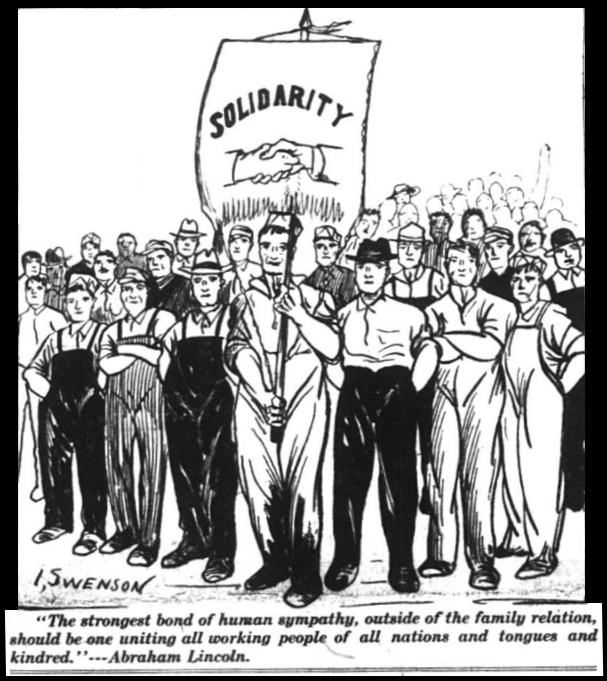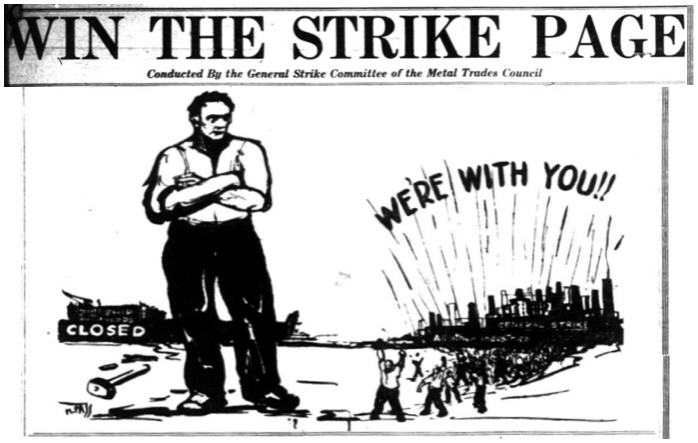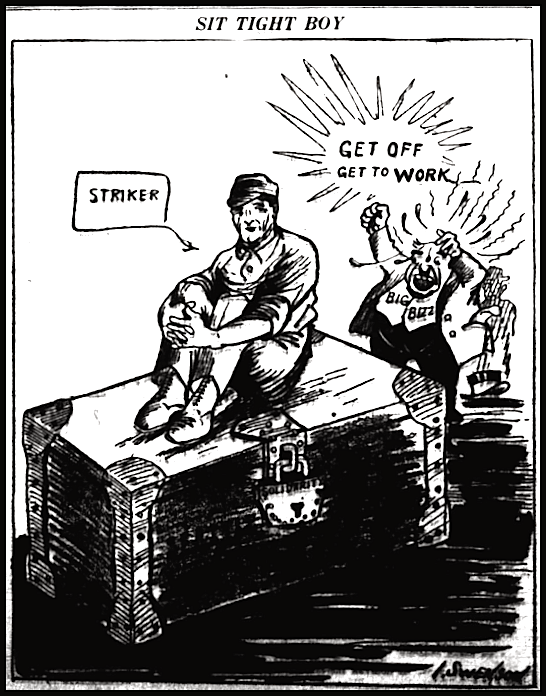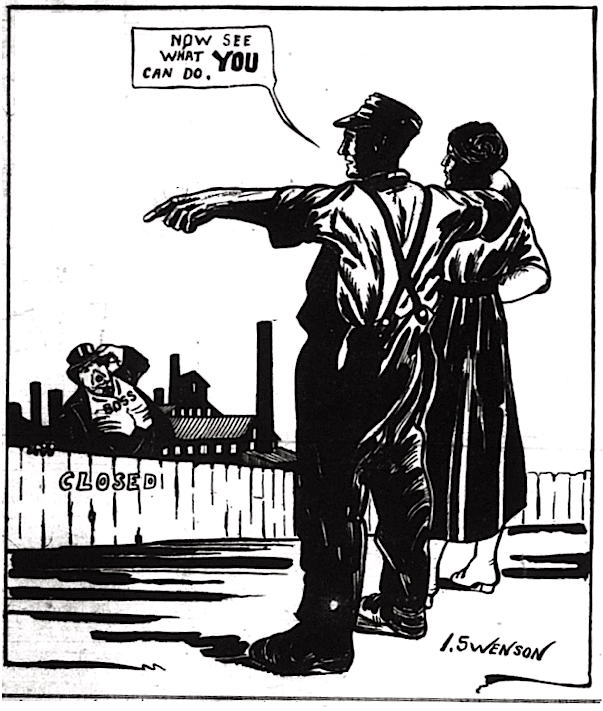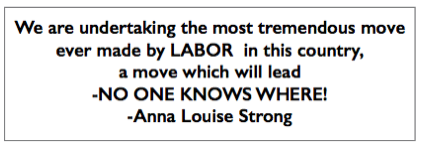 ———-
———-
Hellraisers Journal – Thursday February 20, 1919
Notes on the Seattle General Strike from an Observer
From The Ohio Socialist of February 19, 1919:
Side Lights on Seattle Strike
By An Observer
The five-day general strike of 70,000 Seattle workmen and working women brought about by the refusal of General Mgr. Piez of the Emergency Fleet Corporation to allow ship yard workers to negotiate directly with their employers and threatening to cut off the supply of steel to the local yards if they negotiated directly with the workers, was the most complete walkout that has ever occurred in America. At the same time it was the most peaceful.
The week’s mail has brought us some strike bulletins issued by the strike committee of the workers, and a personal letter from which we quote below. The whole tone of the bulletin is against any interference of the processes of the law or violence of any kind. It repeatedly advises the workers to “keep cool” and to visit the public libraries. The A. F. of L. takes entire responsibility for the strike though of course the I. W. W. and the Socialist Party were active participants.
To quote from the letter:
This is the second day of our general strike. Since its beginning yesterday [February 6th] at 10 o’clock a. m., each hour has added new glories to the achievements of the Seattle labor movement.
I have just returned to my room in the hotel in its sixth story, made accessible by walking the six flights of stairs. The room is exactly as I left it at noon. With a smile and greatest gratification I fail to discern the soft touch of a painstaking chamber maid upon anything. The bed is as I left it, soiled towels are where I threw them, and I am very glad of it.
Among the many female employes of the hotel the only union girl among them pulled all the others out with her yesterday at ten. Several large posters in the hotel lobby announce to guests that as a result of the strike all the employes had walked out, they are requested to take the inconveniences cheerfully.
I went up town at noon to get a meal in one of the 21 union eating houses, practically the only ones in the city operated by the unions themselves in their entirety, operating under a three-hour shift. But going there I must pass through the Japanese quarter. What a sight!
The streets are noiseless with the exception of the clatter of feet along the sidewalks, and here and there a private automobile. Every commercial establishment is closed with the exception of two drug stores. Signs on doors and windows tell the season. “Fair to organized labor;” “Closed for duration of strike;” and some simply have it “Closed.” One Japanese restaurant has on the door a permanent sign. “We Never Close,” but underneath a temporary one saying “We Believe in Labor’s Cause, So We have Closed.” The two adjoining stores have the sign “So Do We.”
The Jewish quarter tell a similar story.
On Yesler Way a funeral procession passed. On the windshields of the hearse and ten hired automobiles following, there was the sign in red letters, “Exempted by Committee.”
Above Yesler Way most of the stores are open for business, but there is no business to do. Restaurants, soft drink places and candy stores are closed.
The sidewalks are not crowded by any means. There are no yelling newsboys and the silk stocking brigade is noticeable for its absence. Store clerks may be seen in the doorways to watch idly the passing crowds; and what there is of it consists of strikers, slowly, but in most cases, smilingly, just like myself, on their way to an eating house or to their strike headquarters.
Looking up Union street on Sixth avenue I noticed an immense crowd of people standing silently on the walks, and in portions of the streets as if waiting for something to turn up. It is there I naturally went.
I could not discover anything to satisfy my curiosity or to learn the cause for this unusual gathering I knew was contrary to all rules of the general strike committee and yet many of the labor police were walking up and down to keep walks clear for the traveling public. City police were nowhere in sight. But arriving at the Union Record building and looking at a poster on the office window, read “Strike Bulletins will be distributed at 2 p. m.” However, it was only 1:10 p. m. then.
Going around to Sixth avenue the crowd was still more dense. Six Union Record automobiles were lined up next to the Record basement entrance, and along the wall of the building fifty or more lusty, noisy newsboys, each striving to be nearest to the basement door and eager to get the first bundle of strike bulletins for free distribution. The newsboys union strike committee had commandeered these boys to do this work of distribution without any remuneration, and yet, greater eagerness for work could not have been displayed by these urchins, had five cents and even more been promised for each copy of the bulletin thus disposed of.
To be sure-
“SOCIALISM WILL DESTROY ALL INCENTIVE FOR WORK!”
The “Seattle star” (Scripps paper) is one block away from the Union Record on Seventh avenue. An empty truck came along on Union street with a policeman armed with a sawed-off shotgun, sitting next to the driver and two discharged soldiers similarly armed behind the seat. I asked of bystanders the meaning of it. I learned that it was this truck which had taken copies of the Star to some place down town.
Going up Seventh avenue and passing the alley I saw emergency police of discharged soldiers, three on each end barring entrance. Seventh avenue was roped off. At each end of the block were four mounted police and perhaps 100 people. In front of the Star building two mounted police and a number of soldier police. To each of these two mounted police a bundle of papers was given for distribution to the waiting small crowds at each end of the roped-off block. To another policeman mounted on a combination motorcycle a bundle of Stars was also given which he took away to some unknown place.
How did the Star come from the press? Upon making this inquiry I learned that men in soldier uniforms designating various grades, among them officers, were acting as strike breakers. It was not known though whether these scabs were discharged soldiers or men from nearby military poses and in the service. Any how, thus a small number of the “Seattle Star” got out on the streets and among the people. Going around the streets later, I noticed heaps of copies of the Star in shreds scattered along the walks and streets, but yet, there were no reports of any kind of disturbances.
After receiving my copy of the Strike Bulletin, reading it as I passed leisurely along, I went up First avenue and coming up opposite the armory, I noticed military trucks lined up there. I remembered then of having read in the Bulletin that regular troops were in Seattle. I went down the hill to see the military sights. I learned that the troops there were from Camp Lewis. A few minutes late eight more trucks loaded with soldiers from Fort Lawton fully equipped for field service arrived.
I wondered what possible work has been laid out for these troops which have been drafted to kill Huns and to make the world safe for democracy. There are no more Huns to be killed and those alive today are on the way to full freedom and the fullest enjoyment of democracy.
It seems that even the policemen have gone on a strike. The few to be seen along the streets seem to feel irritated for lack of work. Happy are those assigned to work for the Seattle Star. Moreover, it seems that Seattle’s “criminals” have joined the strike also. I mean those designated on the police blotter as holdups, burglars and thiefs, not those who get in their work in the office buildings, commercial institutions or members of the Seattle Chamber of Commerce.
During the first 24 hours of the mass strike two thousand policemen in Seattle arrested 32 persons for minor offences (an unusually low number) and not one of these was in connection with the strike.
The hotel clerk just now informs me that some mail had arrived for me. The mailcarriers are about the only workers remaining at the post of duty. I’l walk down six flights of stairs for my mail and back again.
———-
[Photographs added.]
~~~~~~~~~~~~~~~~~~~~~~
SOURCES
Quote Anna Louise Strong, NO ONE KNOWS WHERE, SUR p1, Feb 4, 1919
http://depts.washington.edu/labhist2/SURfeb/SUR%202-19-4%20full.pdf
The Ohio Socialist
“Official Organ of the Socialist Parties
of Ohio, Kentucky, Virginia, West Virginia and New Mexico.”
(Cleveland, Ohio)
-Feb 19, 1919
https://www.marxists.org/history/usa/pubs/ohio-socialist/056-feb-19-1919.pdf
IMAGES
Seattle General Strike, Solidarity by I Swenson, SUR p1, Feb 11, 1919
http://depts.washington.edu/labhist2/SURfeb/SUR%202-19-11%20full.pdf
Seattle General Strike, Metal Trades Council, SUR p3, Feb 4, 1919
http://depts.washington.edu/labhist2/SURfeb/SUR%202-19-4%20full.pdf
Seattle General Strike, Sit Tight Boys, SUR p2, Feb 8, 1919
http://depts.washington.edu/labhist2/SURfeb/SUR%202-19-8%20full.pdf
Seattle General Strike, Now See, SUR p2, Feb 6, 1919
http://depts.washington.edu/labhist2/SURfeb/SUR%202-19-6%20full.pdf
See also:
Tag: Seattle General Strike of 1919
https://weneverforget.org/tag/seattle-general-strike-of-1919/
~~~~~~~~~~~~~~~~~~~~~~~~~~~~~~~~~~~~~~~~~~~~~

